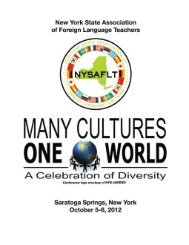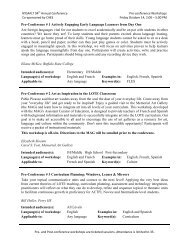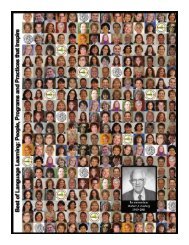THE COMPLETE CURRICULUM Ensuring a Place for the Arts and ...
THE COMPLETE CURRICULUM Ensuring a Place for the Arts and ...
THE COMPLETE CURRICULUM Ensuring a Place for the Arts and ...
- No tags were found...
Create successful ePaper yourself
Turn your PDF publications into a flip-book with our unique Google optimized e-Paper software.
NASBE<strong>THE</strong> <strong>COMPLETE</strong> <strong>CURRICULUM</strong><strong>and</strong> based <strong>the</strong> assessment questionson <strong>the</strong> state’s st<strong>and</strong>ards <strong>and</strong> curriculumframeworks. Un<strong>for</strong>tunately, dueto budget constraints, <strong>the</strong> test is not apart of <strong>the</strong> statewide accountabilitysystem, leaving local districts toshoulder <strong>the</strong> cost if <strong>the</strong>y choose tooffer <strong>the</strong> assessment.The state of policy <strong>for</strong> artseducation is also mixed. Currently, allbut one state has st<strong>and</strong>ards in place <strong>for</strong>what students should be able to learn<strong>and</strong> know in <strong>the</strong> arts. More than half of<strong>the</strong> states require arts education inorder to graduate, while three-quartersm<strong>and</strong>ate some <strong>for</strong>m of arts educationin <strong>the</strong> schools. However, <strong>the</strong>serequirements fall far below those ofo<strong>the</strong>r core subjects. In many states,only 1/2 credit may be required ofstudents in order to graduate fromhigh school, <strong>and</strong> in some cases relatedcoursework (such as industrial arts)may be substituted. Moving frompolicy to practice, many in <strong>the</strong> artseducation field note <strong>the</strong> limitedamount of instructional time that isdevoted to <strong>the</strong> arts in comparison witho<strong>the</strong>r parts of <strong>the</strong> curriculum—despitewhat appears, at face value to be a fairlystrong policy framework.Fur<strong>the</strong>ring <strong>the</strong> marginalization,<strong>the</strong> federal testing requirementsunder NCLB have focused state <strong>and</strong>local policymakers on improvingstudent achievement results inreading <strong>and</strong> math, <strong>and</strong> in doing somaking decisions that increaseinstructional time <strong>for</strong> <strong>the</strong>se specificsubject areas at <strong>the</strong> expense of o<strong>the</strong>rs.In New York City, <strong>for</strong> example, <strong>the</strong>New York Times reported administratorsare scrambling to comply with<strong>the</strong> new st<strong>and</strong>ardized curriculumrequired by <strong>the</strong> state educationagency, which requires more than halfof <strong>the</strong> instructional periods to bededicated to reading <strong>and</strong> math. 15 Theunintended consequence of <strong>the</strong> policyhas been a reduction in arts educationthroughout many schools in <strong>the</strong> city.It is not just educators but <strong>the</strong>public as well that is concerned aboutthis trend. The 35th Annual Phi DeltaKappa/Gallup Poll of <strong>the</strong> Public’sAttitudes toward <strong>the</strong> Public Schools,released in September 2003, found that80 percent of Americans have a greatdeal or a fair amount of concern thatNorth Carolina’s A+ ProgramThe A+ Program is a comprehensive school re<strong>for</strong>m model in NorthCarolina. The program views <strong>the</strong> arts as fundamental to how teachers teach<strong>and</strong> how students learn in all subjects. A+ was implemented in 25 schoolsacross <strong>the</strong> state beginning in 1995. By 2001, 35 schools were participatingin <strong>the</strong> pilot. The program is based on both curriculum <strong>and</strong> instructionalstrategies, as well as organizational strategies that focus on: increasing artsinstruction; fostering two-way arts integration; tapping multiple intelligences;emphasizing h<strong>and</strong>s-on learning; taking an integrated, <strong>the</strong>maticapproach to <strong>the</strong> curriculum; increasing professional collaboration; <strong>and</strong>streng<strong>the</strong>ning schools’ partnerships.Researchers evaluated <strong>the</strong> program from 1995 until 1999, focusing on<strong>the</strong> differences in A+ schools, when compared with schools that had notparticipated in <strong>the</strong> program, after four years of implementation. Keyfindings are:• For schools as a whole, <strong>the</strong> program increased channels of communication,as well as organizational capacity.• A+ increased parent affiliation with <strong>the</strong> school, as well as awareness of<strong>the</strong> curriculum.• Teachers saw instructional change <strong>for</strong> enhanced learning opportunities,as well as opportunities <strong>for</strong> collaborative work <strong>and</strong> new leadershiproles.• For students, A+ enriched <strong>the</strong> academic environment, improvedattitudes, attendance, <strong>and</strong> behavior, <strong>and</strong> garnered assessment results.Initially funded on a year-to-year basis, in 1999 <strong>the</strong> North Carolinalegislature made <strong>the</strong> A+ Program a line item in <strong>the</strong> budget. In addition,<strong>the</strong> program was approved as an acceptable model under <strong>the</strong> ComprehensiveSchool Re<strong>for</strong>m Act, which provided funding <strong>for</strong> four schools toimplement <strong>the</strong> program in 1999. 18“relying on testing <strong>for</strong> English <strong>and</strong>math only to judge a school’s per<strong>for</strong>mancewill mean less emphasis on art,music, history, <strong>and</strong> o<strong>the</strong>r subjects.”In addition, many districts facingrevenue shortfalls are reducing funding<strong>for</strong> <strong>the</strong> arts or completely eliminatingarts programs in order to meet tightbudgets, sometimes <strong>for</strong>cing advocatesto mount extraordinary fundraisingcrusades in order to save programs orpositions (see boxes on pages 11 <strong>and</strong>12






